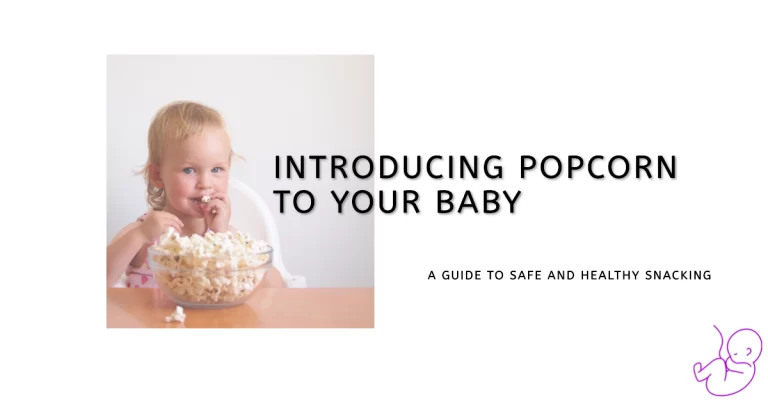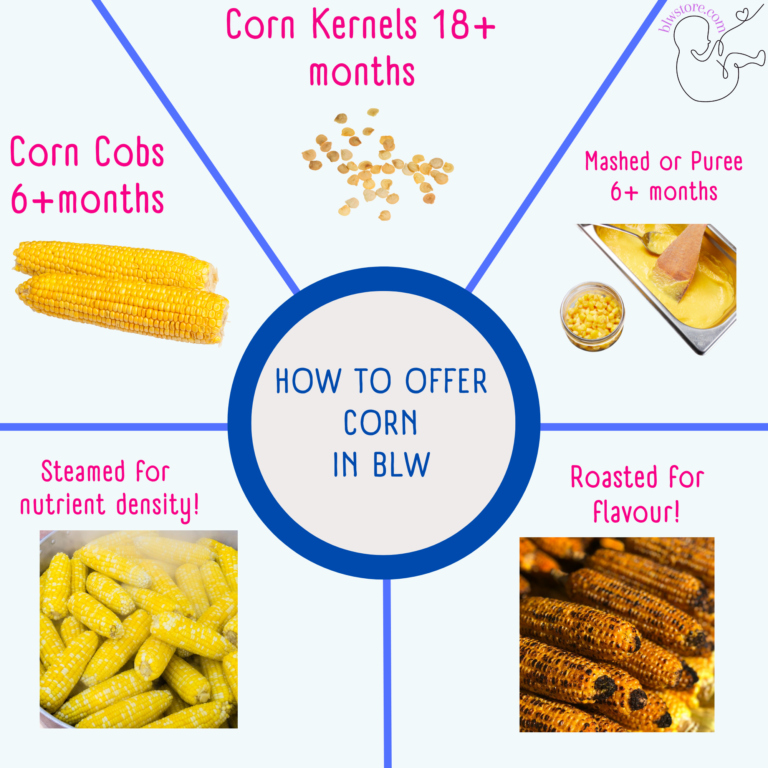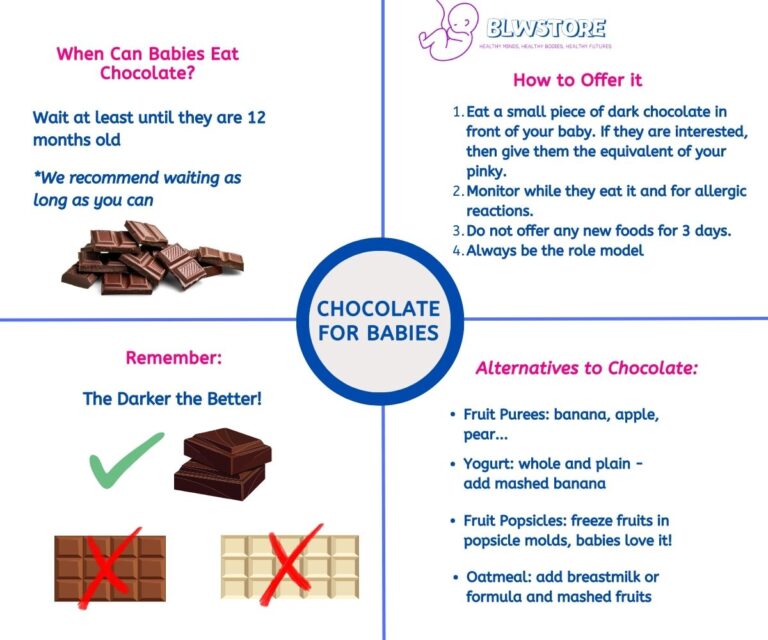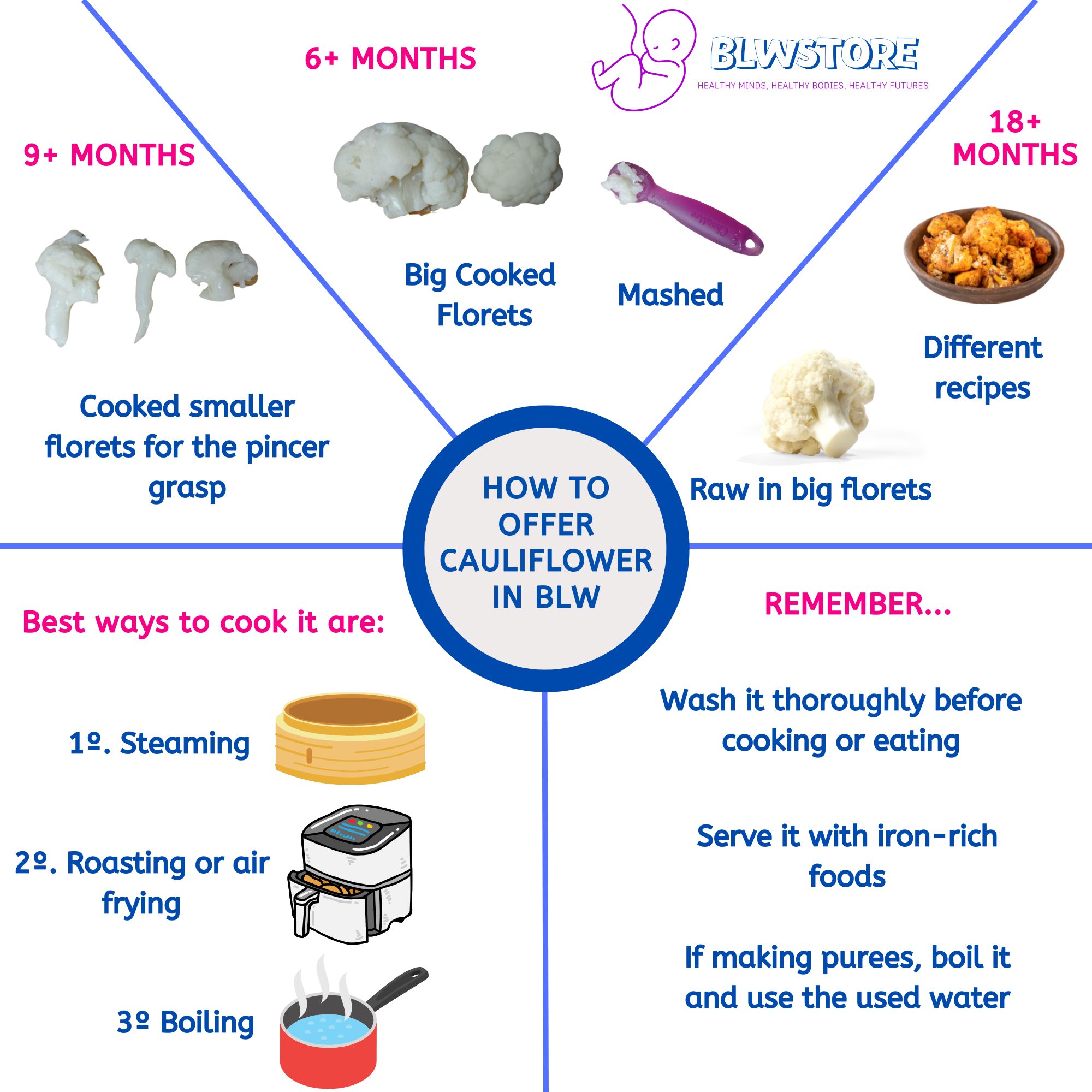
Cauliflower is an excellent way to introduce your kid to various flavors and textures.
Not sure where to begin?
In this article, we’ll go through the benefits of baby-led weaning, how to prepare and serve cauliflower, and answers to frequently asked questions.
You may be confident that you will leave this article knowing everything there is to know about cauliflower for babies.
Let’s get after it!
Key Takeaways
- Babies can start eating solids, including cauliflower, around six months of age. Look for cues such as sitting up with minimal support, reaching for food, and showing signs of chewing.
- Steaming and roasting are the best methods for preparing cauliflower for your baby, as they preserve nutrients and create a soft texture that is easy to eat.
- Offer age-appropriate cauliflower sizes and textures, starting with larger florets for 6-9-month-olds, bite-sized pieces for 9-18-month-olds, and gradually firmer pieces for 18+ month-olds.
- Cauliflower can be combined with various fruits, vegetables, and grains for nutritious purees. Introduce new ingredients one at a time to monitor for allergic reactions.
- Cauliflower is healthy for babies, providing essential vitamins and minerals, including Vitamin C, folate, and Vitamin K. It also contains antioxidants and fiber, which aid digestion.
- Cauliflower allergies are rare but may be linked to allergies to other Brassicaceae foods like broccoli, brussels sprouts, and cabbage.
- Cauliflower can be a choking hazard; follow the advice in the article to prevent dangerous situations.
- Although cauliflower can cause gas, it’s not too gassy for most babies. Introduce it gradually and cook it well to aid digestion.
When can babies eat cauliflower?
At around six months, most babies are ready to start eating solids, including cauliflower.
However, every baby is different, and you should pay attention to their readiness cues before introducing solid foods:
- Able to sit up with little to no support
- Shows interest in food by reaching for it or trying to grab it
- Has reasonable head control and can turn their head away from food they don’t want
- He seems hungry even after getting a full milk feeding
- Begins teething and putting objects in their mouth
- Shows signs of chewing, such as moving their jaw up and down
How to Serve Cauliflower to Baby
What are the best ways to cook cauliflower?
Steaming
Steamed cauliflower is the way to go!
Steaming cauliflower is a great way to preserve its nutrients and a good option for your baby’s developing digestive system. You can use a baby food steamer or add enough water to a pot, bring it to a boil, place a steamer basket with cauliflower pieces over the pot, and cook for 6 to 8 minutes or until tender when pierced.
Steaming is ideal for BLW because it retains the most nutritional value while creating a soft texture that is easy for babies to eat.
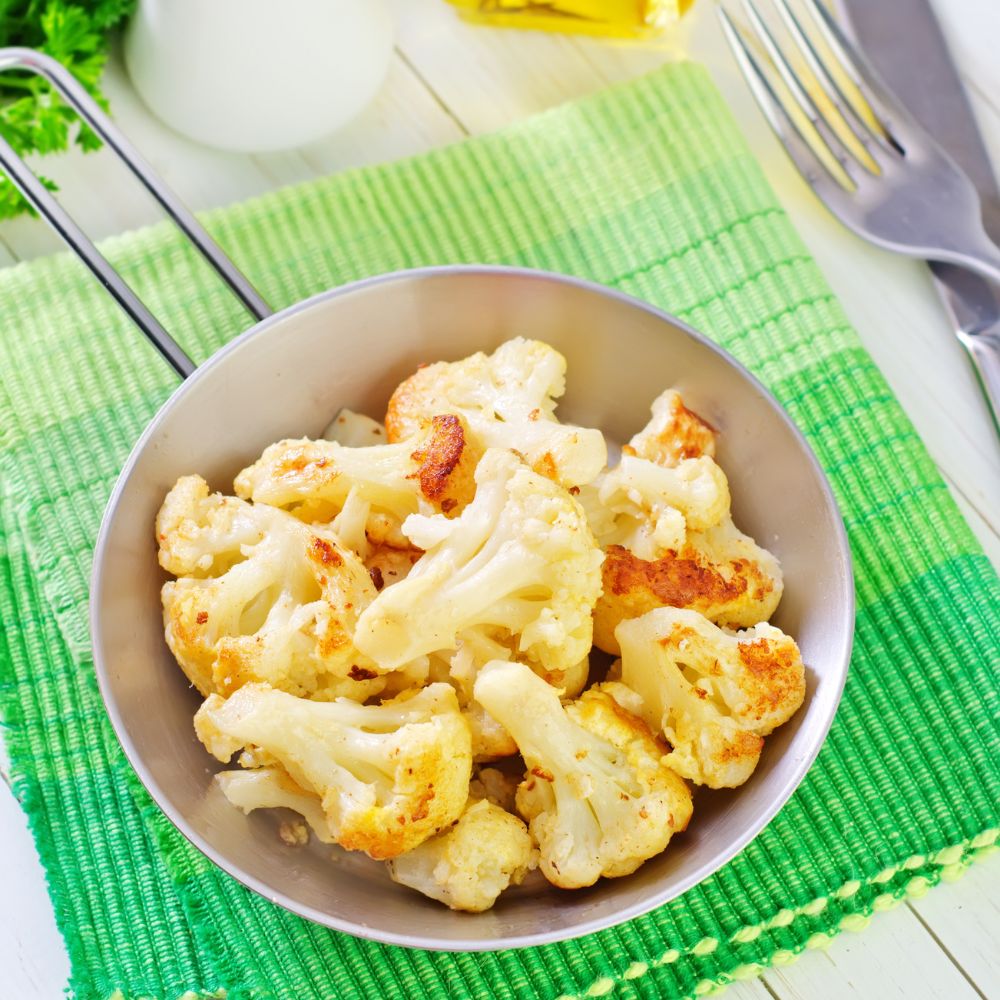
Roasting
Roasting cauliflower can be a delicious option for finger foods. Roasting produces a unique taste due to caramelization in the oven. Cut the cauliflower into florets and place them on a baking sheet.
Drizzle some oil on top and season with sea salt and black pepper for older kids. Roast the cauliflower in the preheated oven at 425F / 220C for 35 minutes. Roasting is a suitable method for exposing your baby to different textures, and it’s perfect for babies nine months and older.
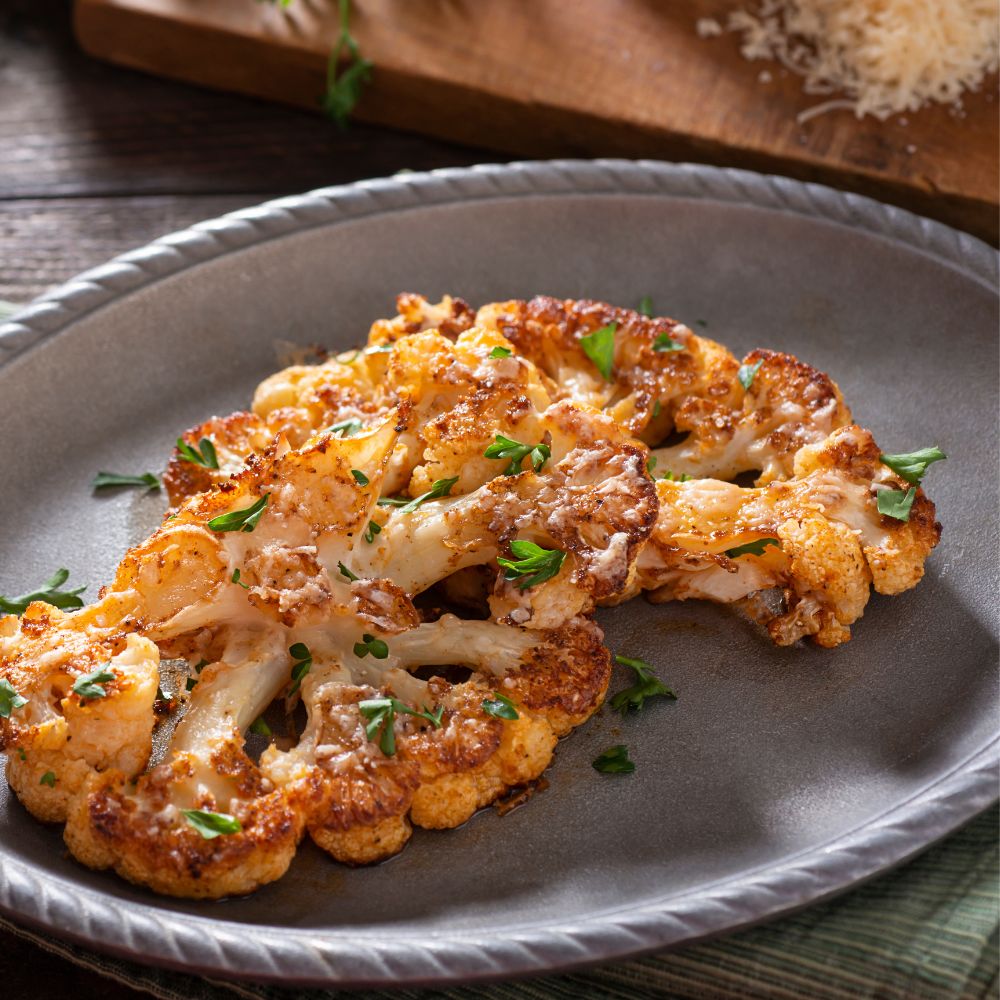
Boling
Boiling cauliflower is the least preferred method for making plain, soft cauliflower florets for babies. Most nutrients will leach into the boiling water you will discard, and half of the nutrients are lost even after boiling for just ten minutes.
This method is perfect for making soups and purees since you can keep the water with all the nutrients.

How to offer cauliflower baby-led weaning
6-9 months
For babies in this age range, larger pieces of food are easier to handle and encourage the development of oral motor skills.
Large florets of soft cooked cauliflower cut in half vertically are perfect for your little one to grasp and gnaw on.
If you are worried about choking, you can also mash the cauliflower for your baby to scoop.
If you are unsure you can always prepare some cauliflower puree in a food processor
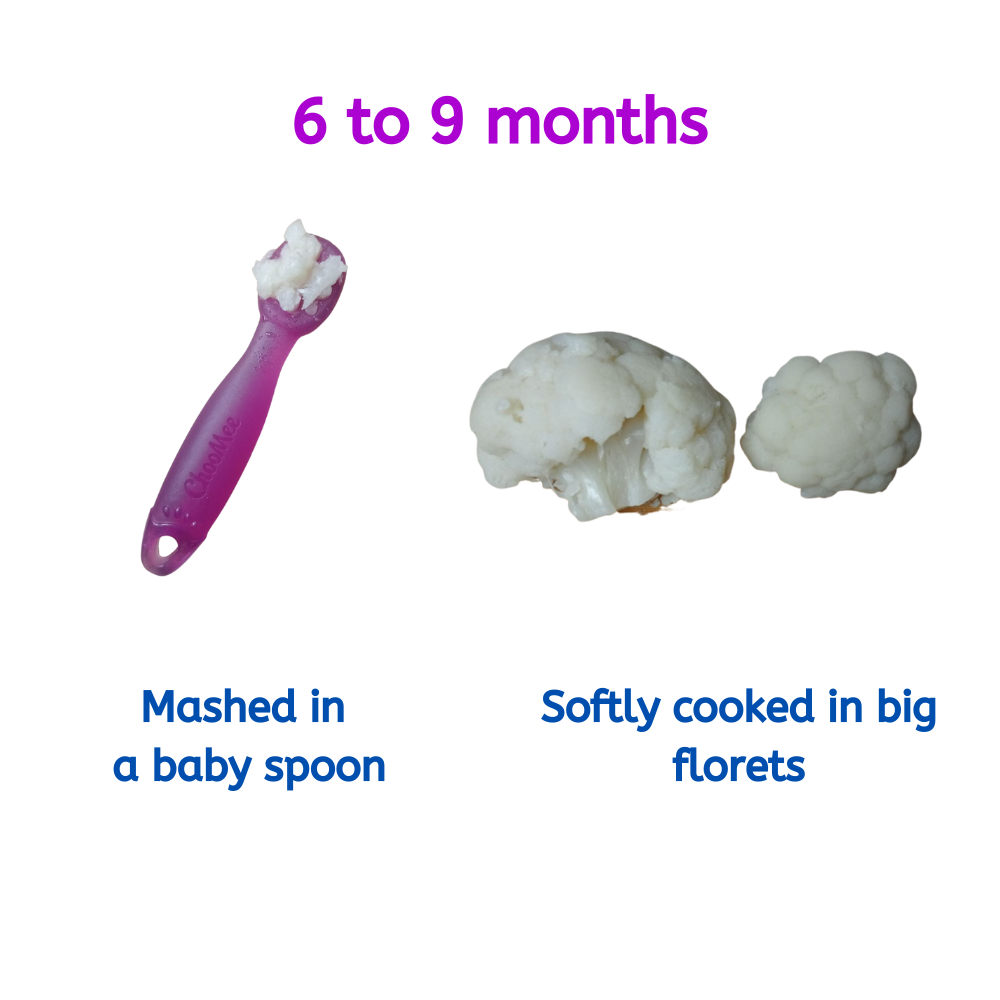
9 to 18 months
As your baby’s pincer grasp develops, you can offer smaller bite-sized pieces of cooked cauliflower florets.
You can still offer larger florets for them to gnaw on and use this as an opportunity to model taking bites. Always eat with your baby.
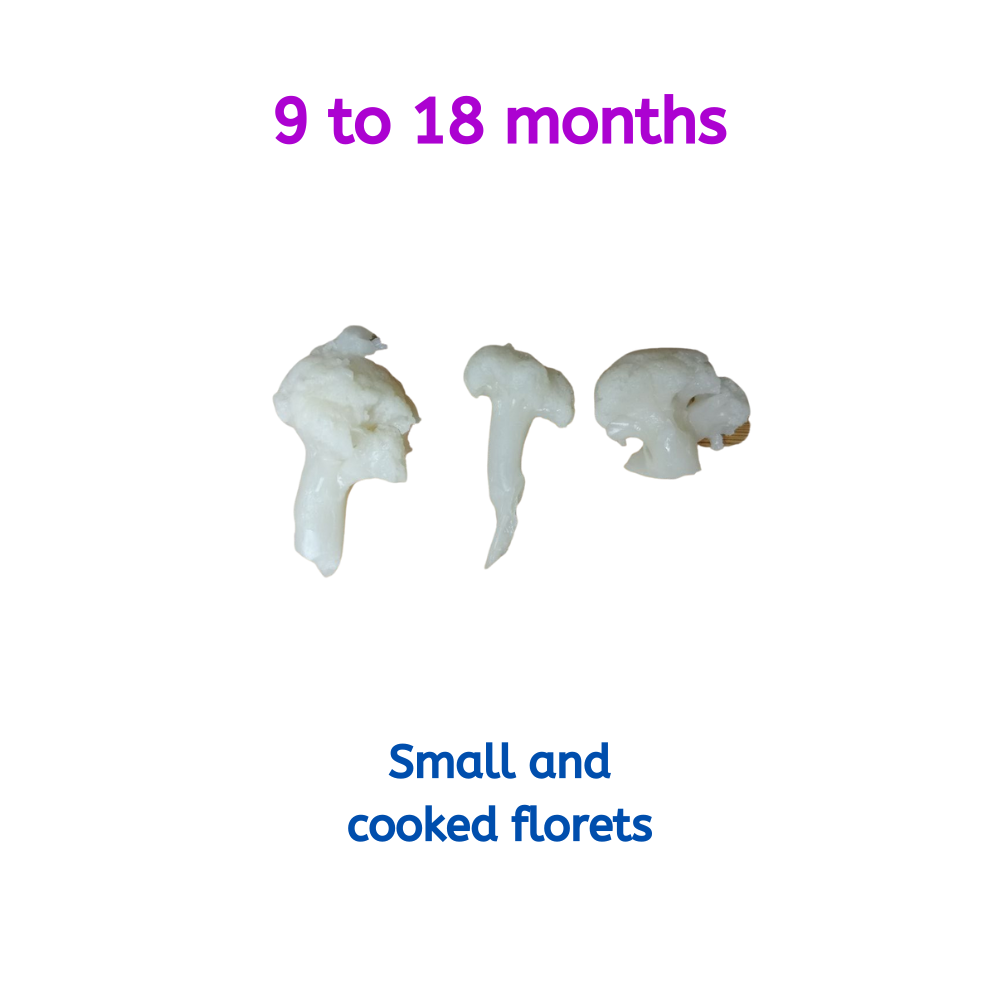
18+ months
As your little one’s chewing and swallowing abilities improve, you can continue offering cooked cauliflower florets on their own and as part of shared meals.
You can even pre-load a fork with bite-sized pieces of cooked cauliflower to encourage the use of utensils, like baby spoons of forks.
As they approach 24 months, try decreasing the cooking time so that the cauliflower is not entirely soft.
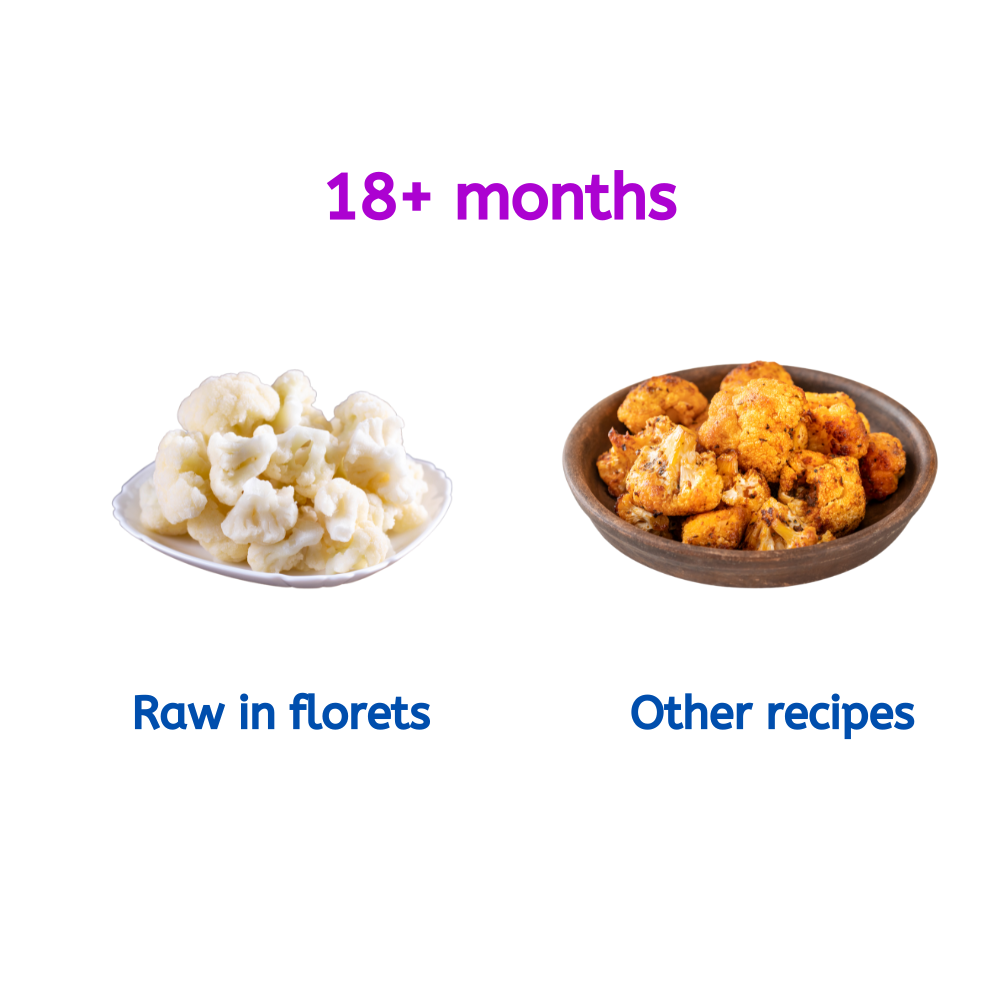
Remember that steaming and roasting are the best cooking methods for your baby’s cauliflower. They are excellent options that will ensure that your baby gets the most nutrition and will create soft textures that are easy to eat.
What are the best Puree combinations with Cauliflower?
– Cauliflower with sweet potatoes: Cauliflower and sweet potatoes go nicely together. To prepare a creamy and nourishing puree, steam both veggies and mix them with some breast milk or infant formula.
– Butternut squash and cauliflower go well together since the latter has a sweet and nutty flavor that complements the former’s mild flavor. Both vegetables are roasted, pureed with a little milk, and served as a nutritious and delectable puree.
– Carrots and cauliflower are two more fantastic vegetables to combine. They naturally sweeten the purée and give it an orange colour. For added taste, mix the steamed vegetables with a small amount of chicken or vegetable broth.
– Apples naturally sweeten and add fiber to any puree, as do cauliflower and apples. To make the ideal puree, roast some cauliflower and combine it with some cooked and pureed apples.
– You could add cauliflower to your BLW chicken nuggets and make them more nutritious! Or even in a BLW quesadilla!
Is Cauliflower Healthy for Babies?
Cauliflower has lots of Vitamin C, an essential component that strengthens the immune system and aids in the body’s iron absorption, which is vital for babies when they start solids.
It is also a good source of folate, crucial for brain development, and vitamin K aids blood clotting. It also includes minerals like magnesium and potassium, which help maintain strong bones and muscles.
Yet cauliflower has advantages that go beyond just being nutrient-rich. Antioxidants, which help shield your baby’s cells from harm and may lower the chance of developing chronic diseases later in life, are also abundant.
Is Cauliflower a Common Allergen?
Although some people could react negatively after eating cauliflower, these occurrences are extremely rare.
It’s crucial to remember that if your baby has an allergy to cauliflower, they might also have an allergy to other Brassicaceae foods like broccoli, brussels sprouts, and cabbage.
Is Cauliflower a choking hazard?
Yes, it can be.
Like most solid foods, cauliflower has the potential to be a choking hazard for babies and young children. The cauliflower florets are round and can quickly get stuck in the throat, blocking the airway.
Follow the advice in this article to prevent dangerous choking situations.
Is Cauliflower too gassy for babies?
Like many other cruciferous vegetables, cauliflower contains complex carbohydrates that can give both adults and babies gas.
However, this does not necessarily imply that it is “too gassy” for infants. Most infants can handle cauliflower without any issues.
It’s crucial to introduce cauliflower to your kid gradually; start with tiny servings and progressively increase them.
Their digestive system will have time to adjust, lessening discomfort or excessive gas.
Cooking and softening cauliflower can lessen the likelihood of gas formation and aid with digestion.
You can experiment with lowering the serving amount or providing it alongside other foods that are simpler to digest if you discover that your infant is uncomfortable after eating cauliflower.
Is cauliflower hard for babies to digest?
Cauliflower is generally not thought to be difficult for babies to digest.
It has a lot of fiber, which helps with digestion and encourages regular bowel movements.
Recipe Ideas for Cooking with cauliflower for babies
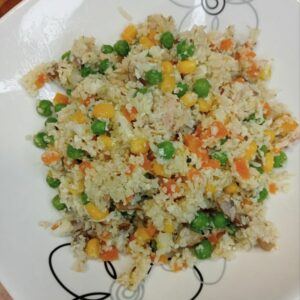
Cauliflower Fried Rice
Ingredients
- 1/2 head cauliflower grated
- 1/2 spring onion chopped
- 1/2 cup canned sweet corn no added sugar or salt
- 1 can tuna in olive oil
- 1 cup mushrooms chopped
- 1/2 cup frozen peas
- 1 carrot chopped
- White pepper and Provencal herbs to taste
Instructions
- Wash the cauliflower thoroughly and grate it until it looks like rice.
- In a pan, sauté the spring onion, garlic (if using), mushrooms, peas, and carrot until cooked through.
- Add white pepper and Provencal herbs to taste.
- Add the grated cauliflower and stir until it's combined with the veggies. Cook for about 10 minutes or until the cauliflower is soft.
- Once there is no more water in the pan, add the can of tuna and corn.
- Serve and enjoy!
Notes
- You can add other vegetables of your choice such as bell peppers, broccoli, or zucchini.
- This dish can be made vegan by omitting the tuna.
- This dish can be served as a side dish or a main dish.
- Leftovers can be stored in the fridge for up to 3 days.


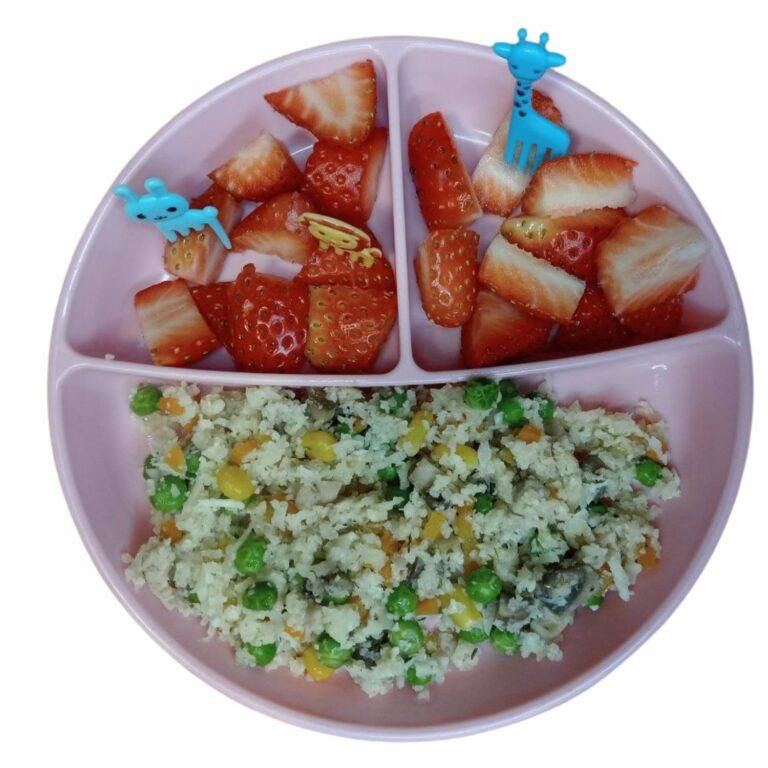
Oven-Roasted Cauliflower Bites | 6+ months
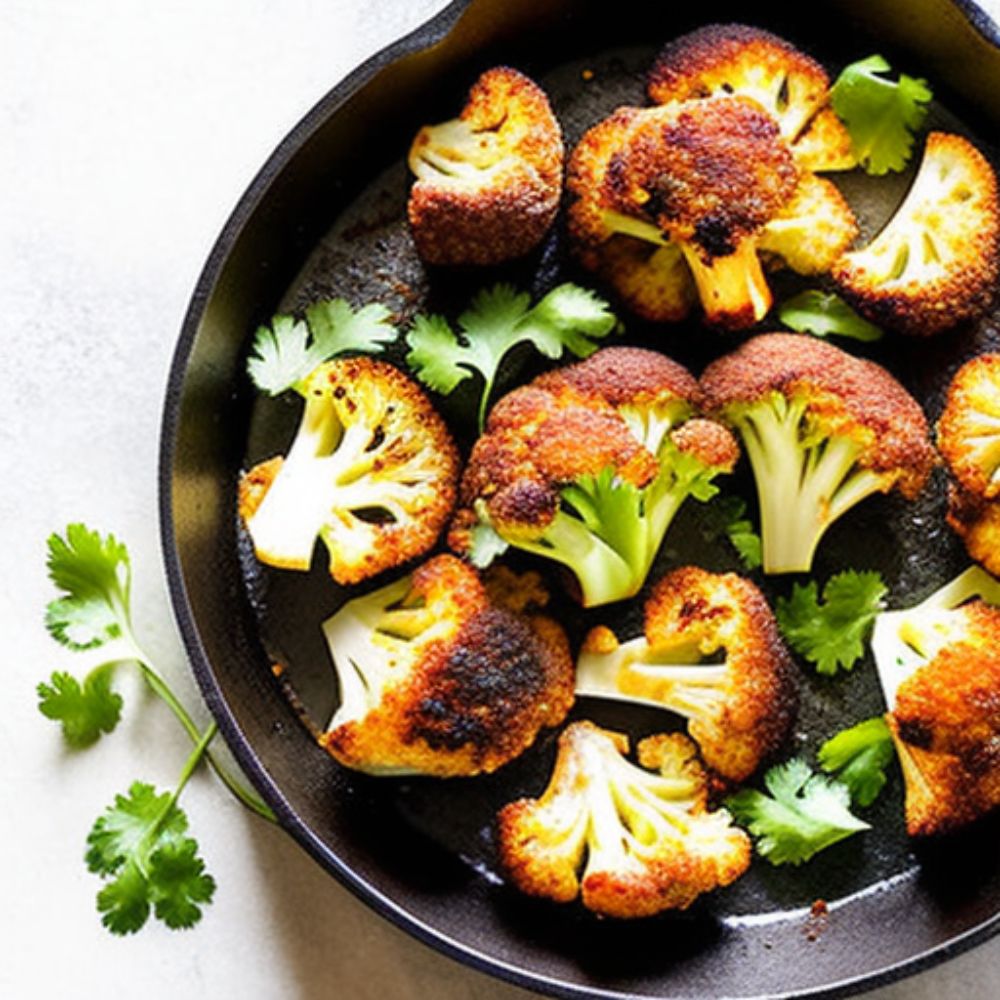
Ingredients:
- 1 head of cauliflower, cut into small florets
- 1 tablespoon olive oil
- 1/2 teaspoon garlic powder
- 1/2 teaspoon paprika
- Pepper to taste
Instructions:
- Preheat the oven to 400°F (200°C).
- Place the cauliflower florets on a baking sheet.
- Drizzle the olive oil over the cauliflower and toss to coat evenly.
- Sprinkle the garlic powder, paprika, and pepper over the cauliflower and toss to coat.
- Roast the cauliflower in the oven for 20-25 minutes or until tender and lightly browned.
- Allow the cauliflower to cool slightly before serving it as finger food or a side dish to your baby.
Cauliflower and Broccoli Frittata | 9+months
Ingredients:
- 1/2 head of cauliflower, cut into small florets
- 1/2 head of broccoli, cut into small florets
- 2 eggs, beaten
- 1/4 cup riccota cheese
1 tablespoon olive oil
- Pepper and other spices to taste
Instructions:
- Preheat the oven to 375°F (190°C).
- In a large skillet, heat the olive oil over medium heat.
- Add the cauliflower and broccoli florets to the skillet and cook for 5-7 minutes or until tender.
- In a bowl, whisk together the eggs, ricotta cheese, and spices.
- Pour the egg mixture over the vegetables in the skillet.
- Place the skillet in the oven and bake for 15-20 minutes or until the frittata is set and lightly golden on top.
- Allow the frittata to cool slightly before slicing it into small pieces for your baby to practice their pincer grasp.
Cauliflower for Babies FAQ
Is it better to boil or steam cauliflower?
Steaming is better since it preserves more nutrients.
However, if you make purees or soups, boiling might be a better option since you can use the water.
Can babies eat cauliflower rice?
Of course. It is one of our favorite ways of eating cauliflower.
However, you might want to wait until your baby can use a spoon before offering cauliflower rice so that they can feed themselves.
How do you properly wash cauliflower for your baby?
To properly clean cauliflower for your baby, follow these 6 simple steps:
- Break the cauliflower into smaller pieces.
- Rinse the cauliflower florets under running water.
- Blanch the florets in boiling salt water for about 2 minutes.
- Transfer the florets to an ice water bath to stop the cooking process.
- Dry the cauliflower with a clean kitchen towel or paper towel.
- Cook immediately or store in a loose plastic bag in the fridge.
Reference: MasterClass website
Tips for softening cauliflower without boiling
Microwaving is the fastest way to soften cauliflower without boiling it. Cover it with a microwave-safe lit for 3-4 minutes or until the florets are soft and tender.
We’re Maria and Alberto, a married couple and educators who are nutrition enthusiasts. Even before we had kids, we were already crazy about nutrition.
We’d read scientific articles, watch videos from nutritionists, and spend hours listening to nutrition podcasts.
Today, we continue doing this, but in a different way, as we’ve learned to sift through the noise and trends. Nutrition, like any other field of knowledge, the more you read and learn, the more you develop a comprehensive understanding of reality, and that’s what has happened to us.
Before having our first child, we focused on learning everything we could about child nutrition, using the same techniques we had already employed, backed by our extensive knowledge in nutrition.
Our mission is to help other parents with their children’s nutrition, to help them become the best versions of themselves.
If we are what we eat and drink, which is absolutely true, let’s do it right!


